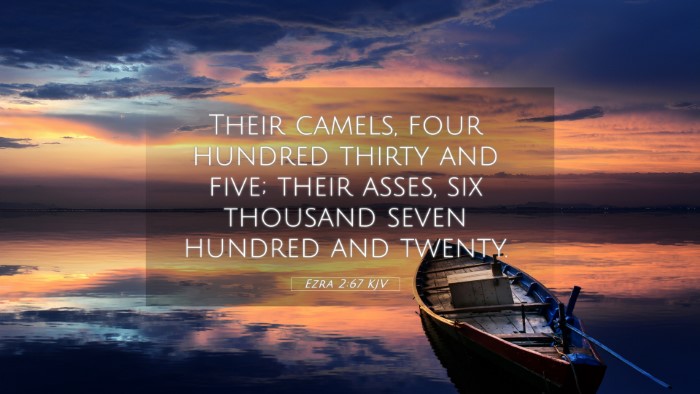Understanding Ezra 2:67
Ezra 2:67 states:
"They had 670 horses, 245 mules, 435 camels, and 6,720 donkeys."
Summary of the Verse
This verse provides an account of the number of animals that accompanied the people of Israel during their return from Babylonian exile to Jerusalem. It highlights the resources available to them, marking a significant logistical detail as they reintegrated into their homeland.
Interpretation from Public Domain Commentaries
Insights from respected commentaries provide valuable perspectives on this passage:
Matthew Henry's Commentary
Matthew Henry emphasizes the importance of this enumeration, attributing it to God's providence and the restoration of Israel. He notes that the animals mentioned symbolize not only provisions for the journey but also reflect God's blessing upon the returning exiles.
Albert Barnes' Notes on the Bible
Albert Barnes interprets the details of the verse as significant for understanding the wealth and means that the returning community possessed. He comments on how such resources were vital for rebuilding efforts in Jerusalem, highlighting the interconnectedness of physical and spiritual restoration.
Adam Clarke's Commentary
Adam Clarke provides insight into the types of animals listed, linking them to their utility in agricultural and trade activities upon returning to Jerusalem. He argues that the specifics of the inventory point to both the practical needs of the population and their societal structures as they reestablished their lives.
Significance of Resources
The mention of the animals in Ezra 2:67 serves multiple purposes:
- Historical Context: Understanding the people’s journey and their preparations for agriculture and rebuilding.
- Symbol of Blessing: Reflecting God's provision and favor upon the exiles.
- Logistical Planning: Indicating the necessary resources for establishing a new life in Jerusalem.
Bible Cross References
Ezra 2:67 can be cross-referenced with several other verses that provide deeper connections and context:
- Nehemiah 7:68-69: Offers a similar enumeration of animals during the return from exile, emphasizing the continuity of the narrative.
- Deuteronomy 8:9: Discusses the blessings of the promised land, which include plentiful resources such as livestock.
- 2 Chronicles 36:22-23: Connects the events of the return to the fulfillment of Jeremiah's prophecy regarding returning to Jerusalem.
- Isaiah 43:5-6: Portrays God's promise of gathering His people from the ends of the earth, linking them to the theme of restoration.
- Psalms 126:1-6: Reflects the joy of the return to Zion, enhancing the emotional landscape of circumstances surrounding Ezra's return.
- Haggai 1:8: Encourages the rebuilding of the temple, showcasing the importance of resources in the restoration process.
- Jeremiah 29:10: Highlights God's plan for the exiles, affirming their return and rebuilding work.
Connections between Bible Verses
The various cross-references indicate a strong thematic link concerning the restoration of God's people and the significance of community resources. This inter-Biblical dialogue enriches the understanding of Ezra 2:67, demonstrating how God’s providential care throughout Israel's history is a recurring motif.
Exploring Further
Utilizing tools for Bible cross-referencing can deepen understanding of themes and connections within scripture. For example:
- Bible concordance: Helps in tracing references and themes across different books.
- Bible cross-reference guide: Assists in finding related verses and expanding contextual insights.
- Cross-reference Bible study: A method for analyzing how different scriptures engage with one another, enriching personal study.
Conclusion
Ezra 2:67 encapsulates a rich narrative of God's provision and the restoration of His people. The animals listed are more than mere numbers; they signify a journey back to wholeness as the Israelites prepare to rebuild their lives and community. Understanding this verse in the context of related passages deepens one’s comprehension of God's unfolding plan and themes of restoration throughout the Bible.
In studying this verse and its cross-references, one may discover not just historical facts, but spiritual truths that resonate through the entirety of the scriptural narrative.


